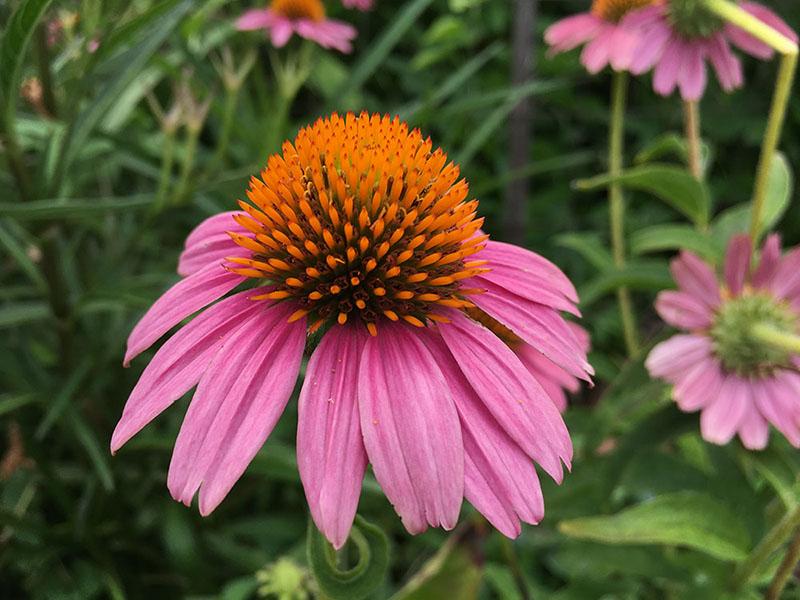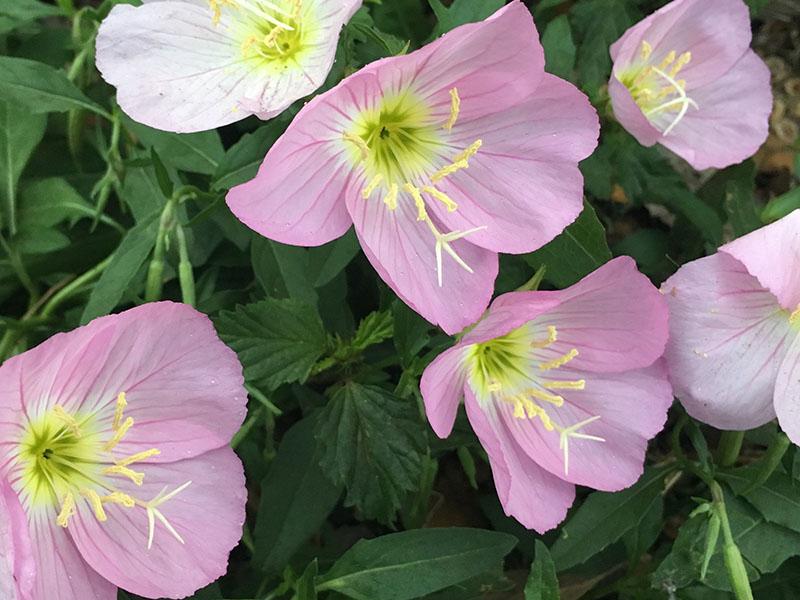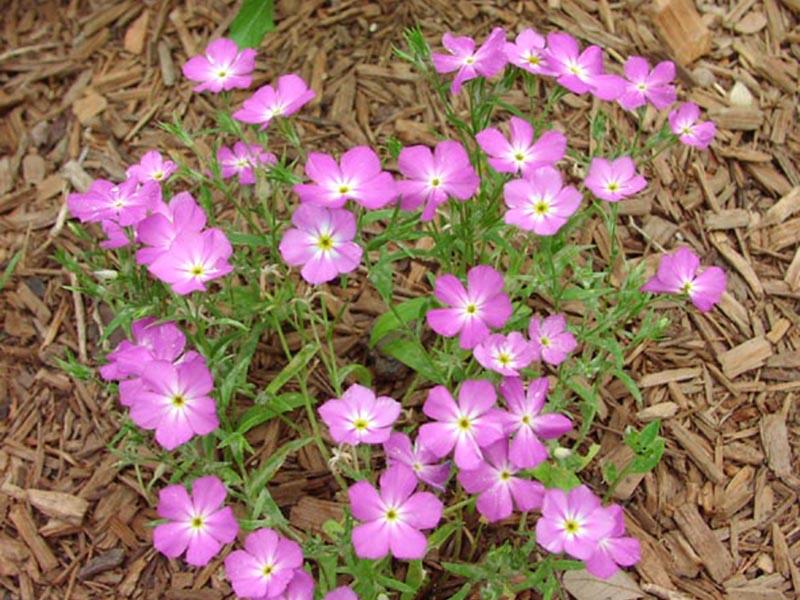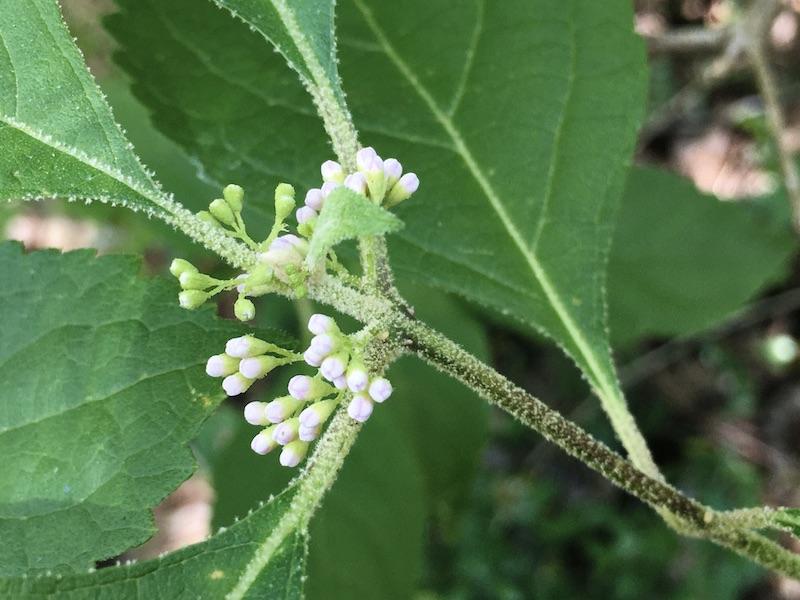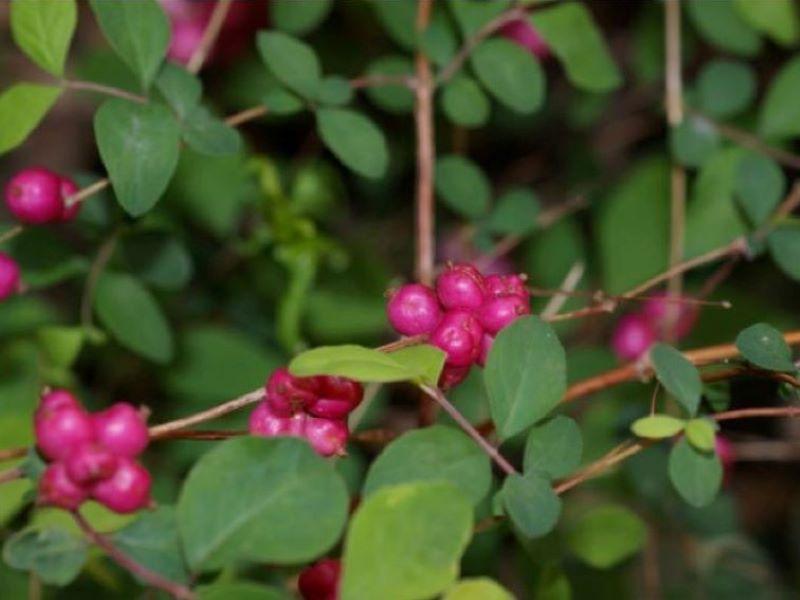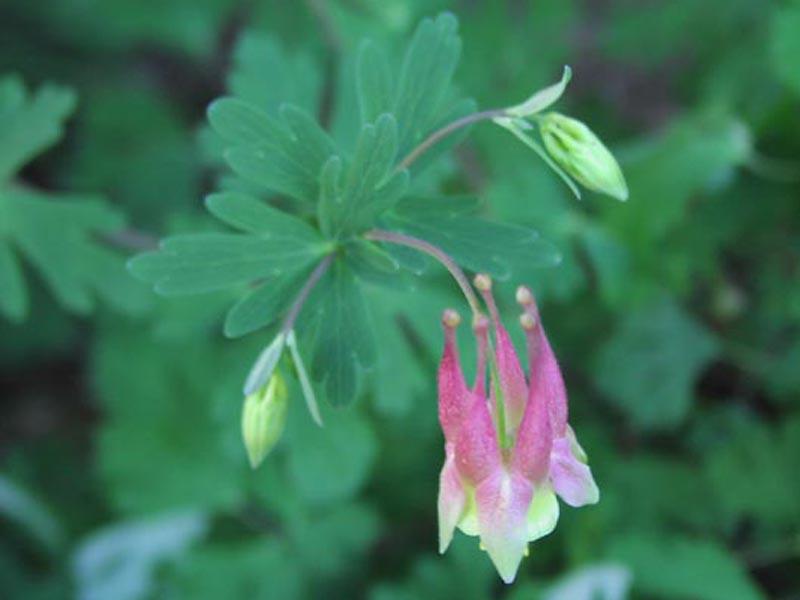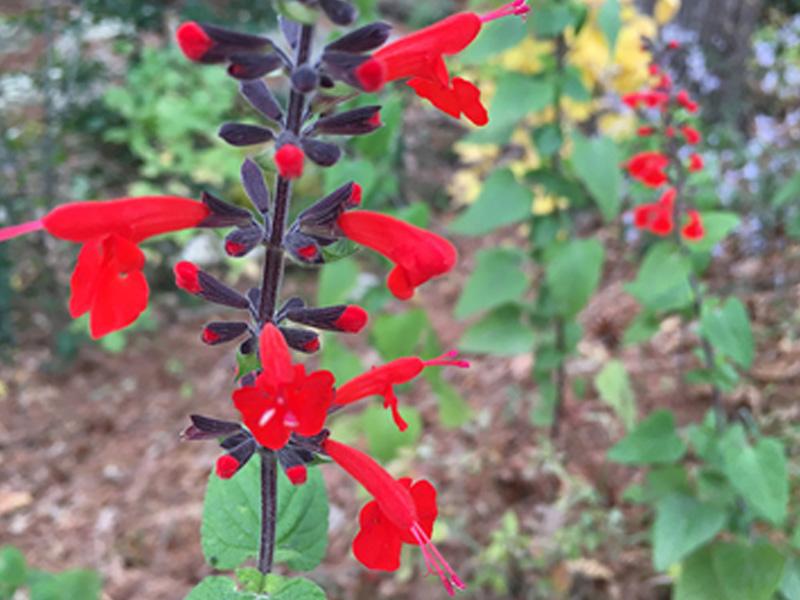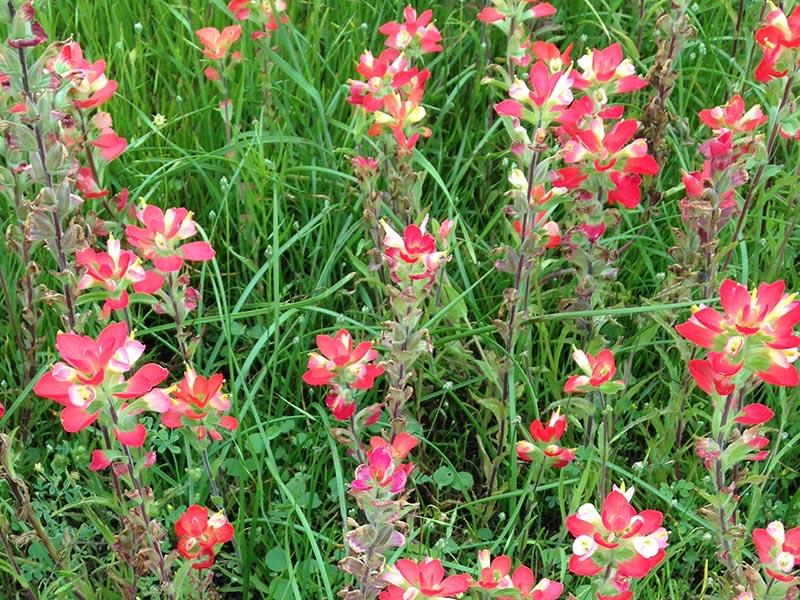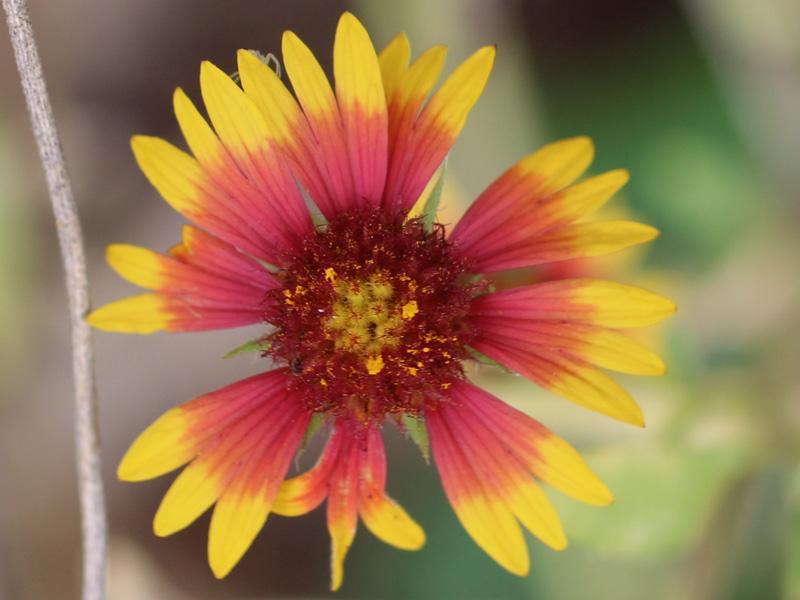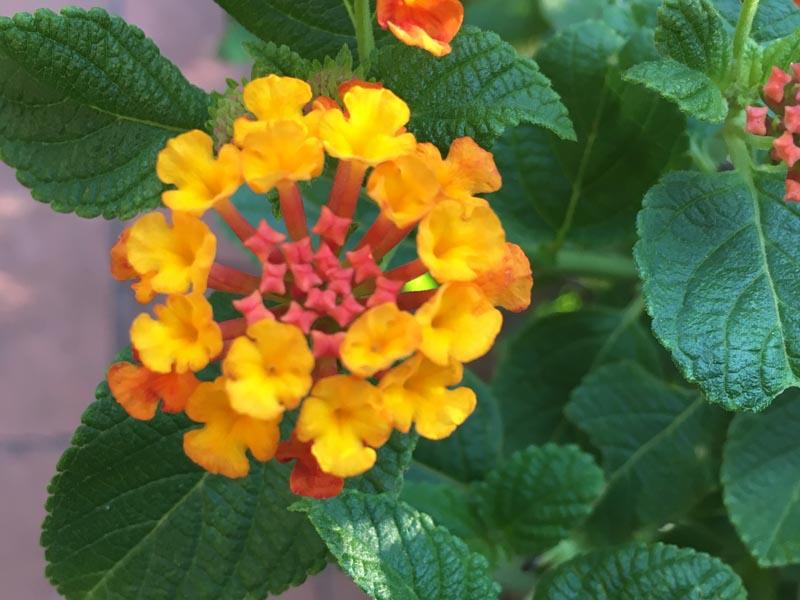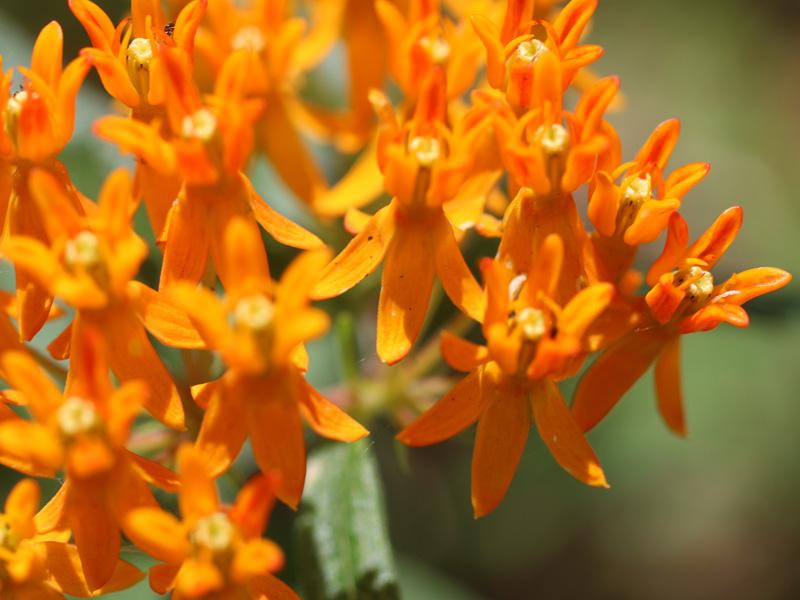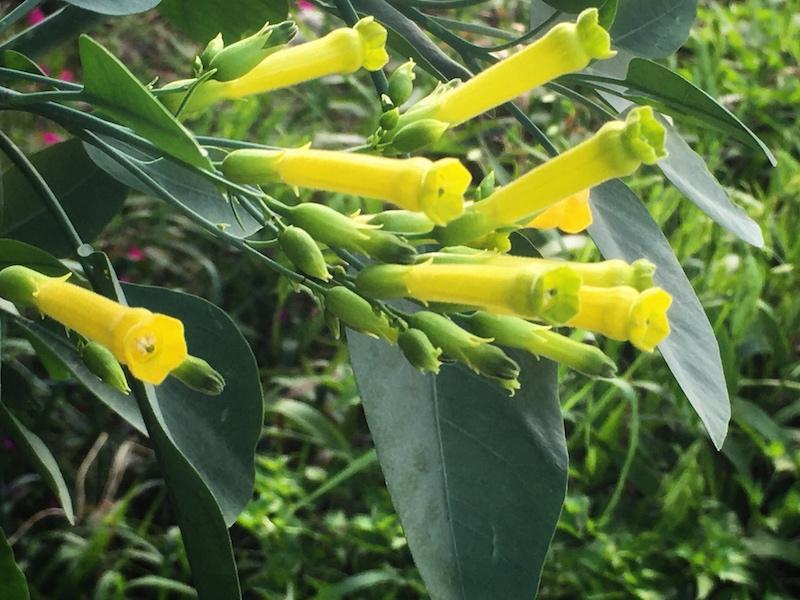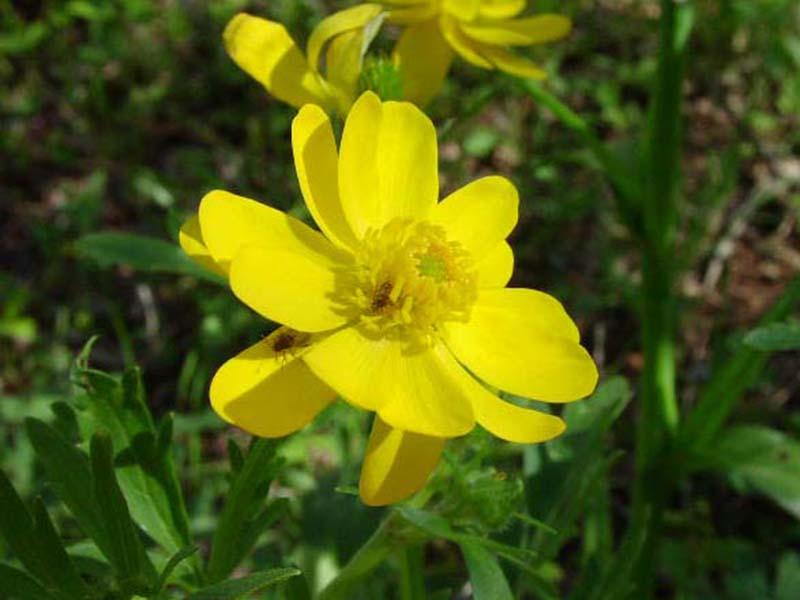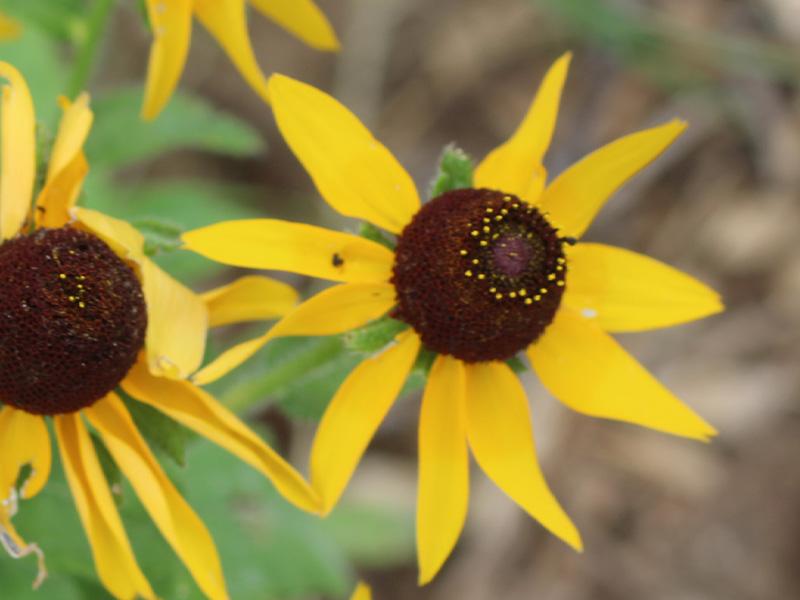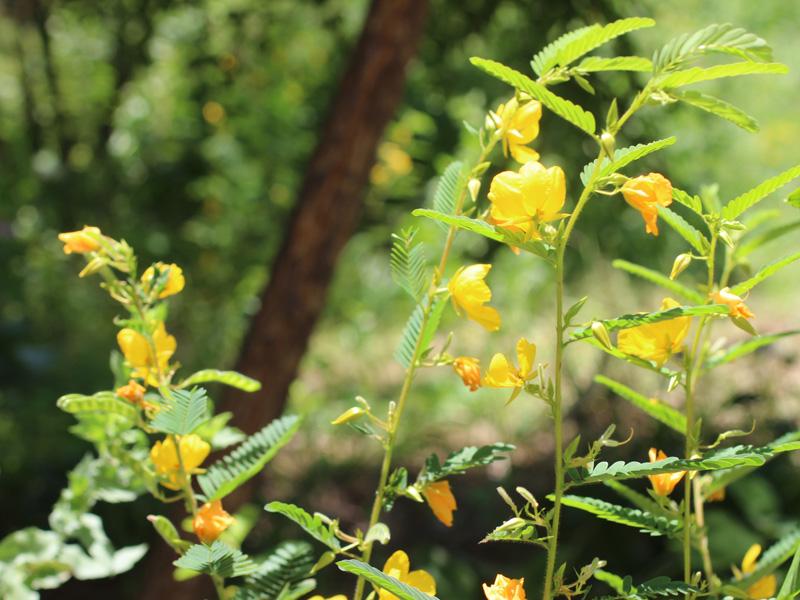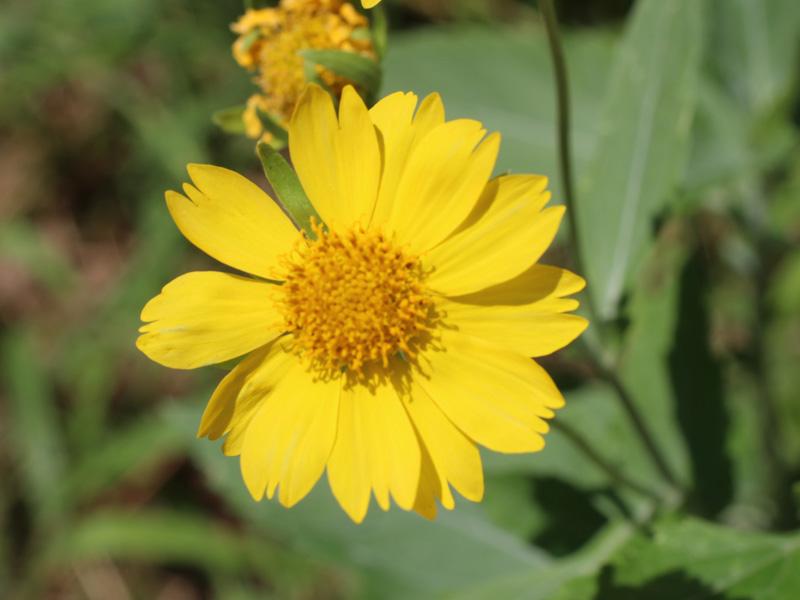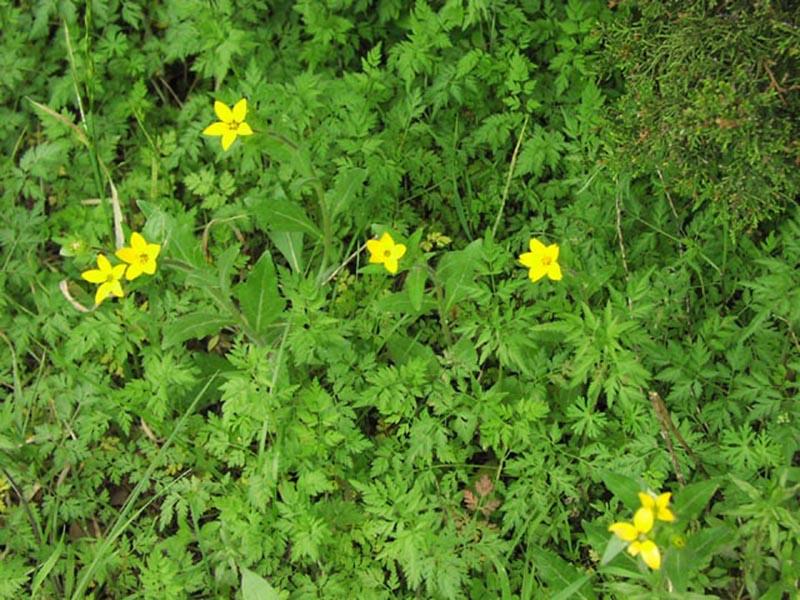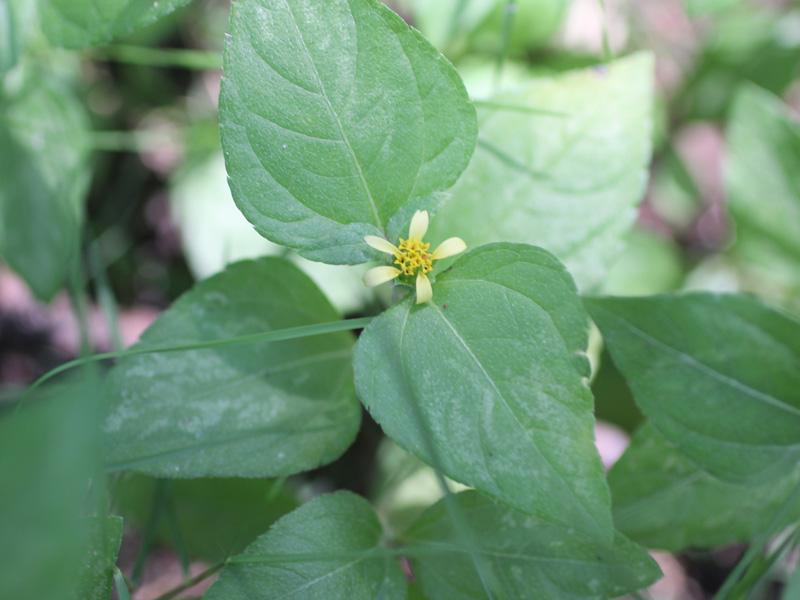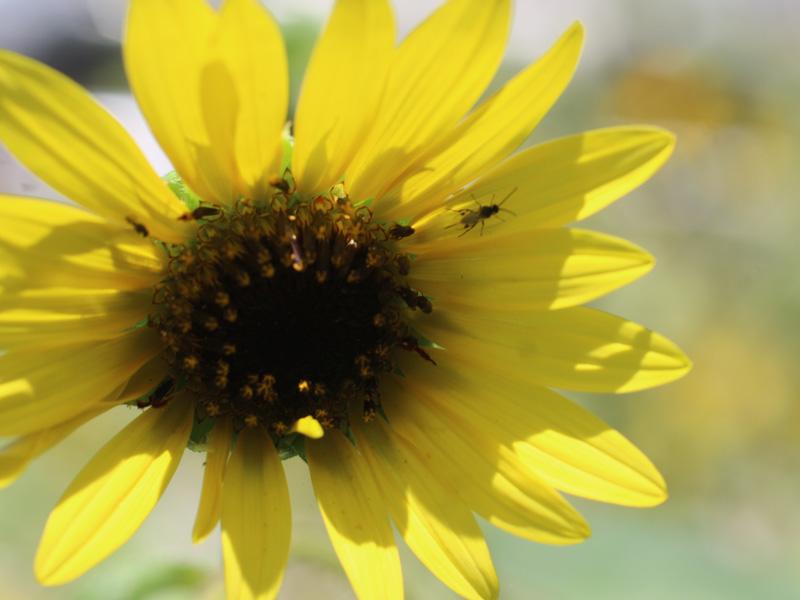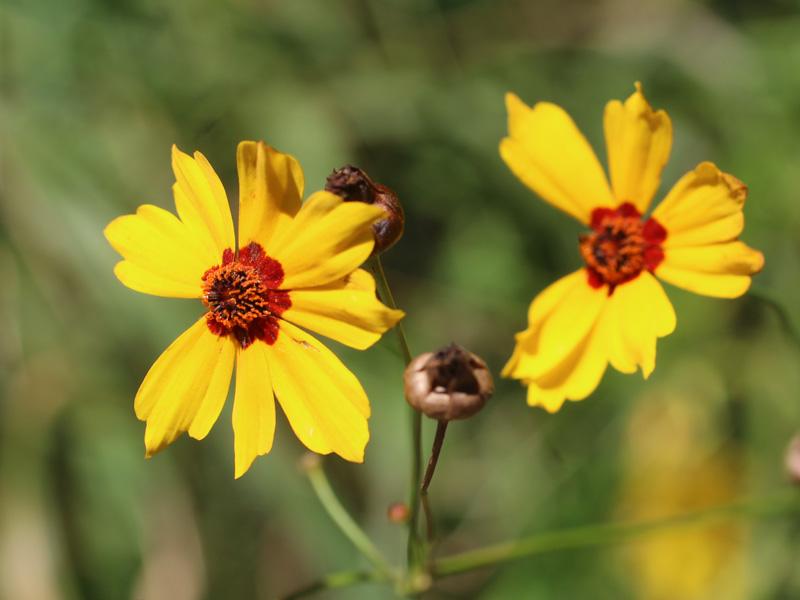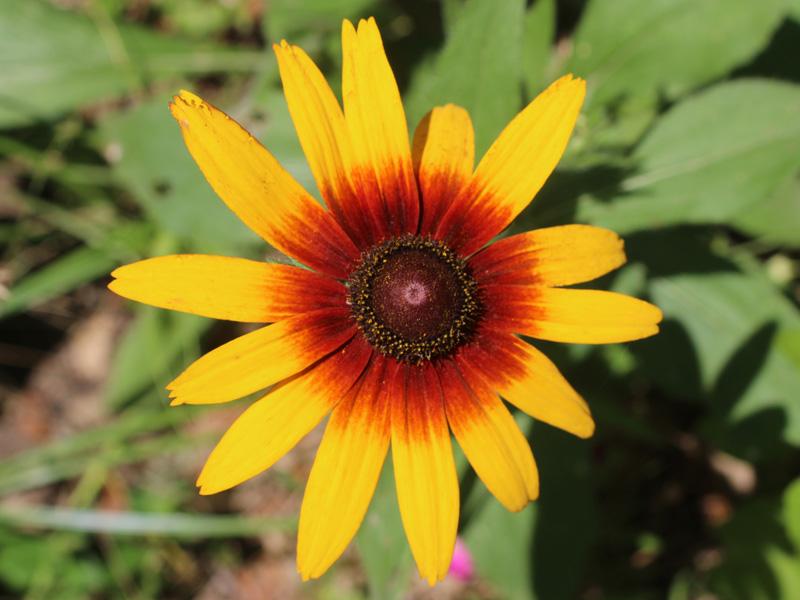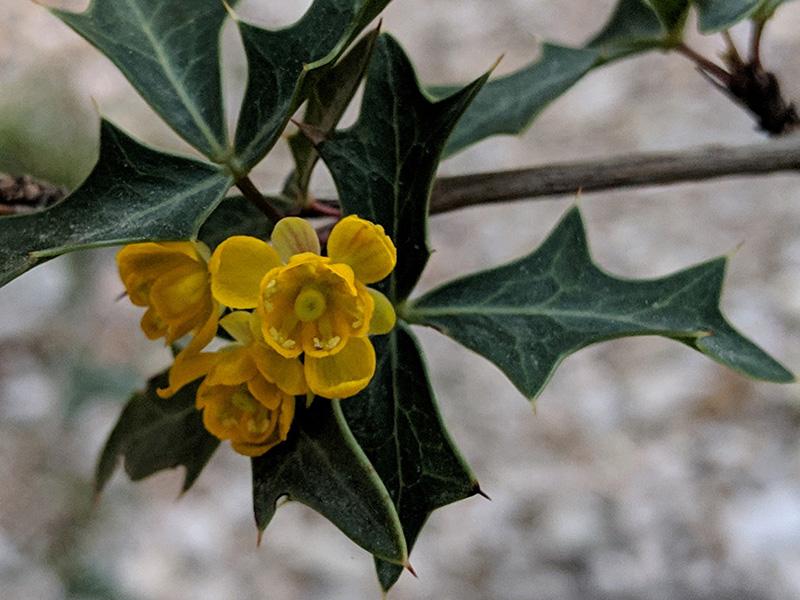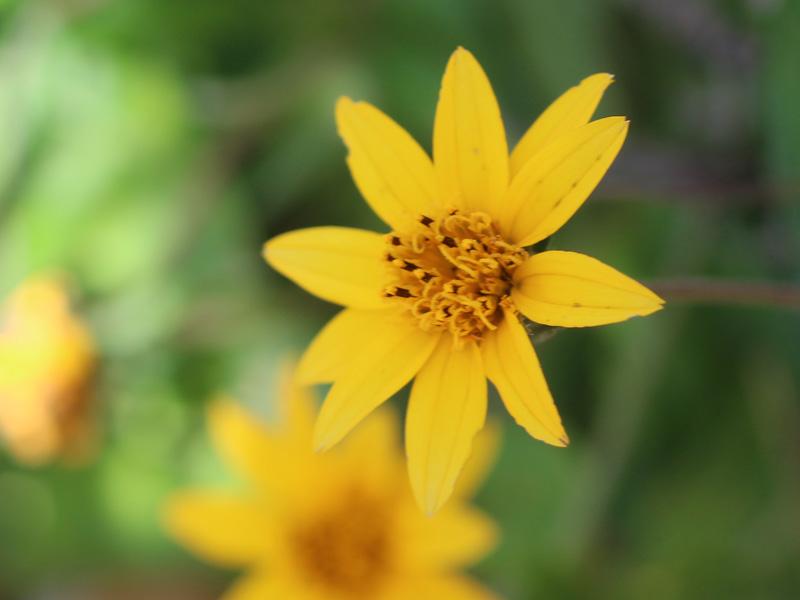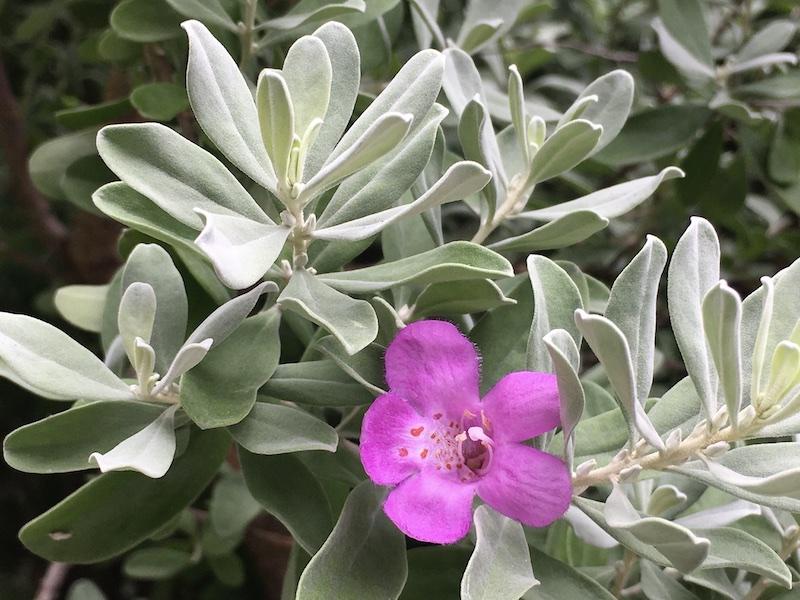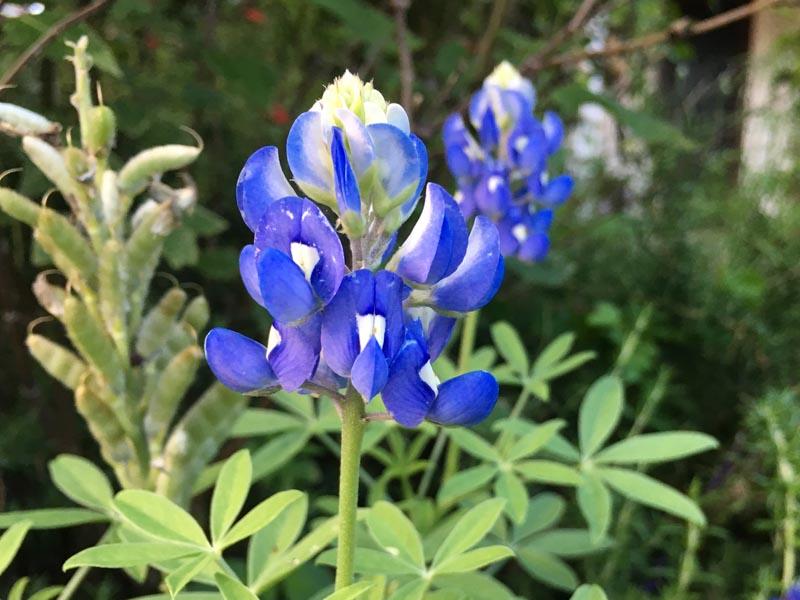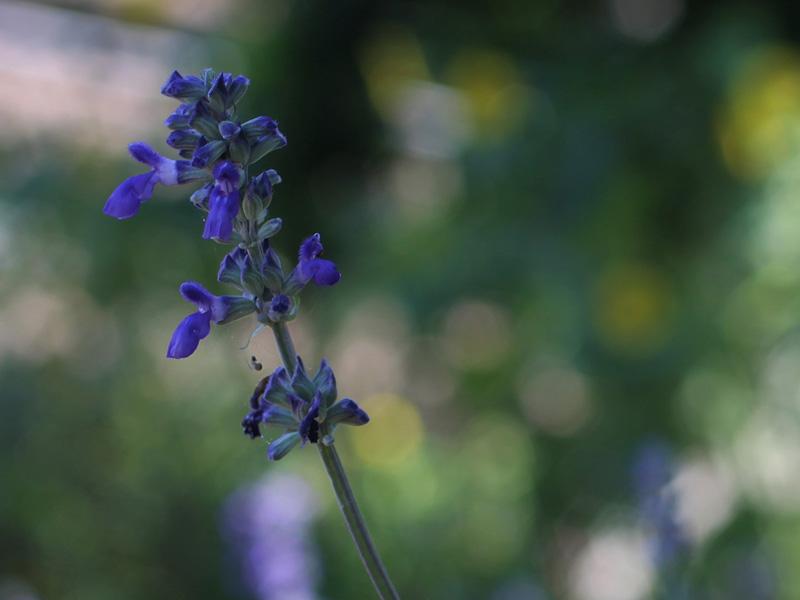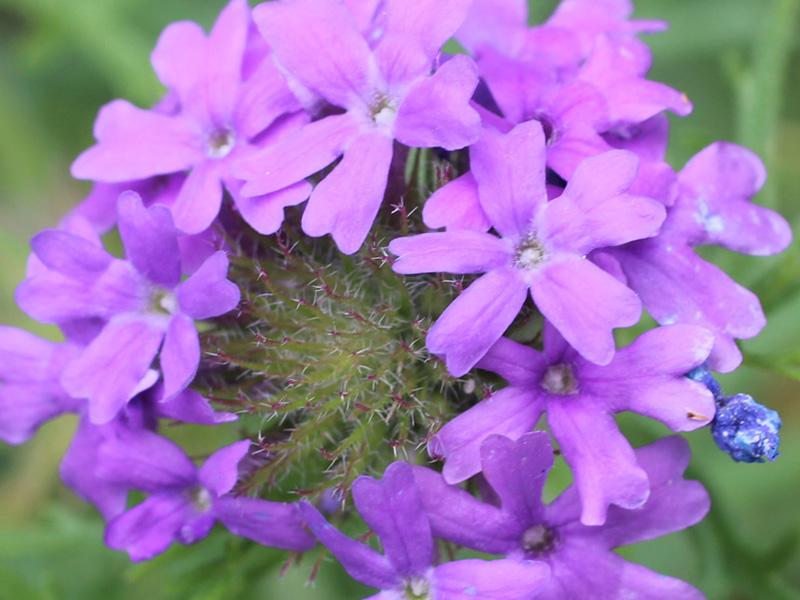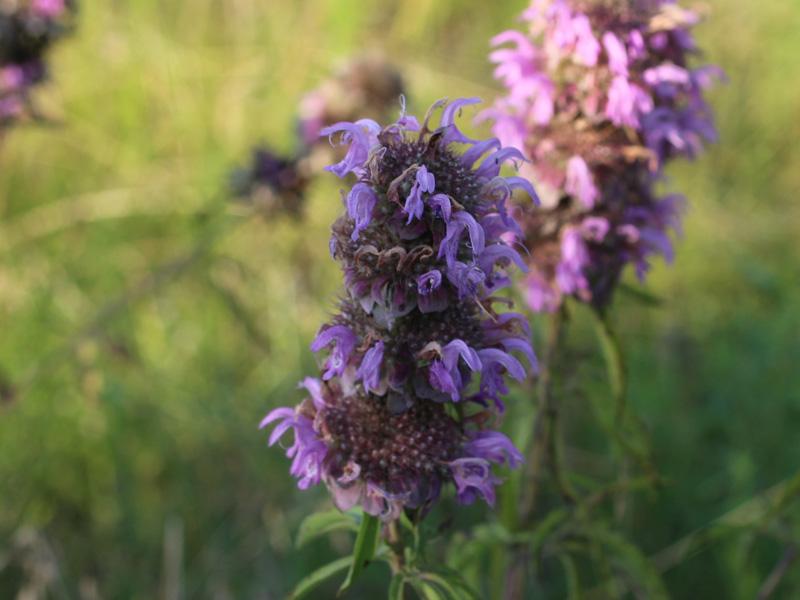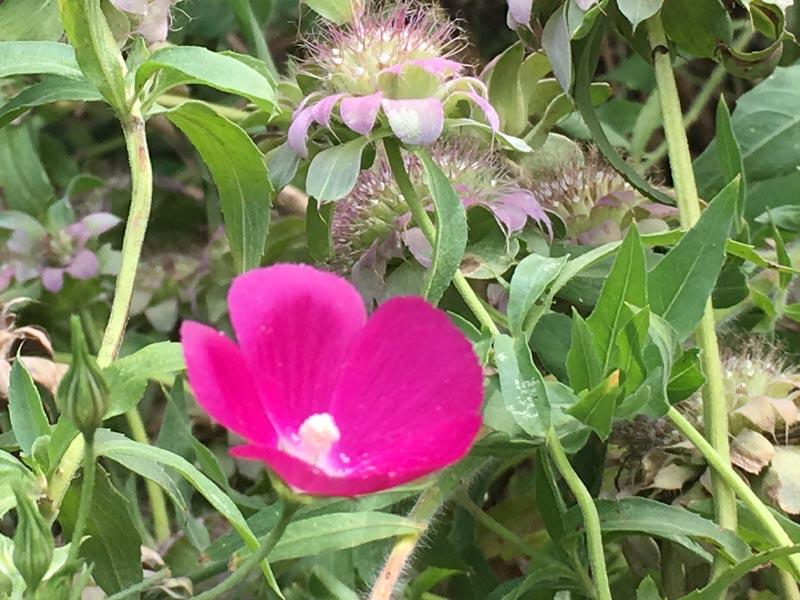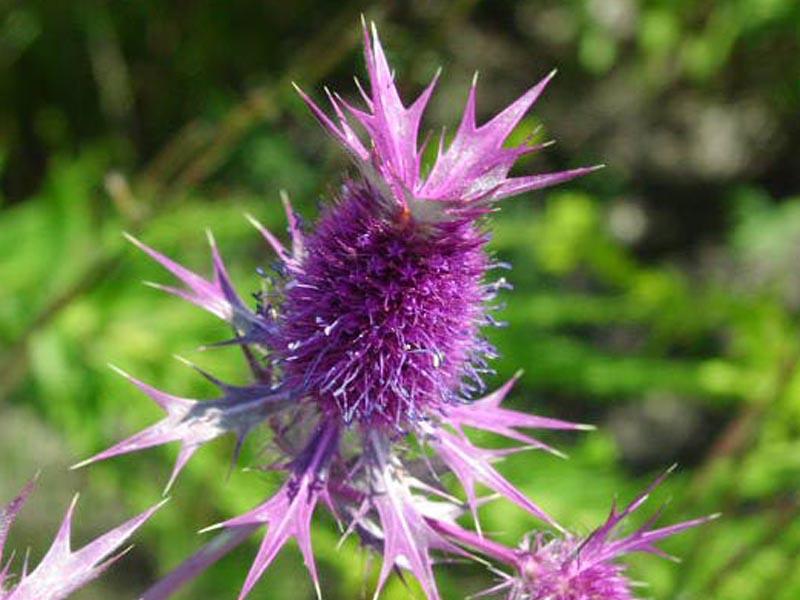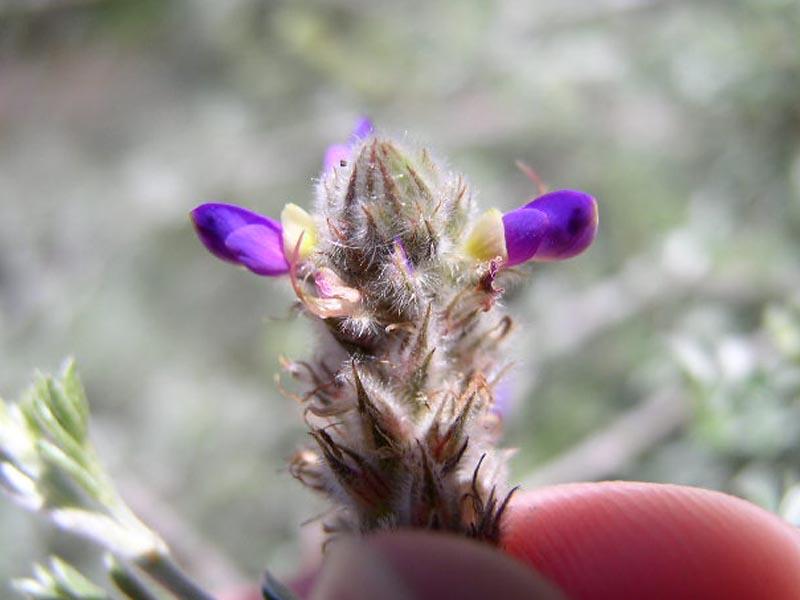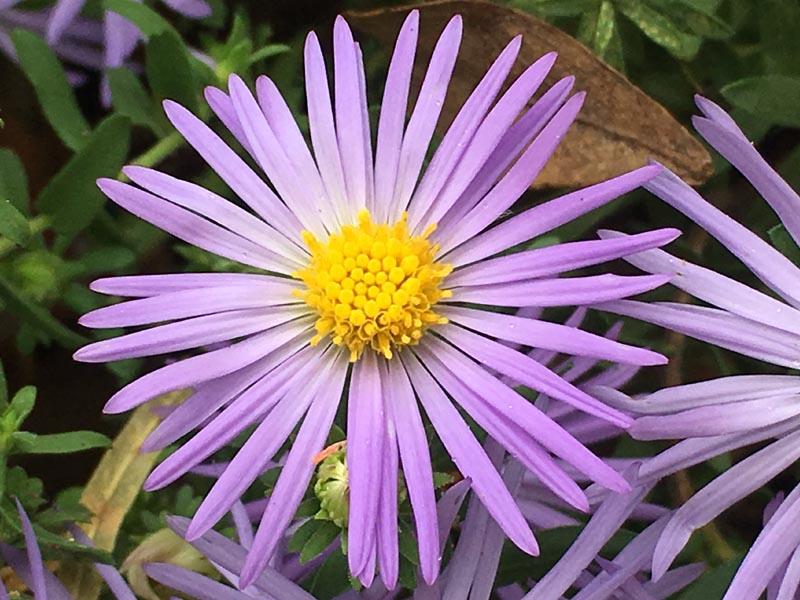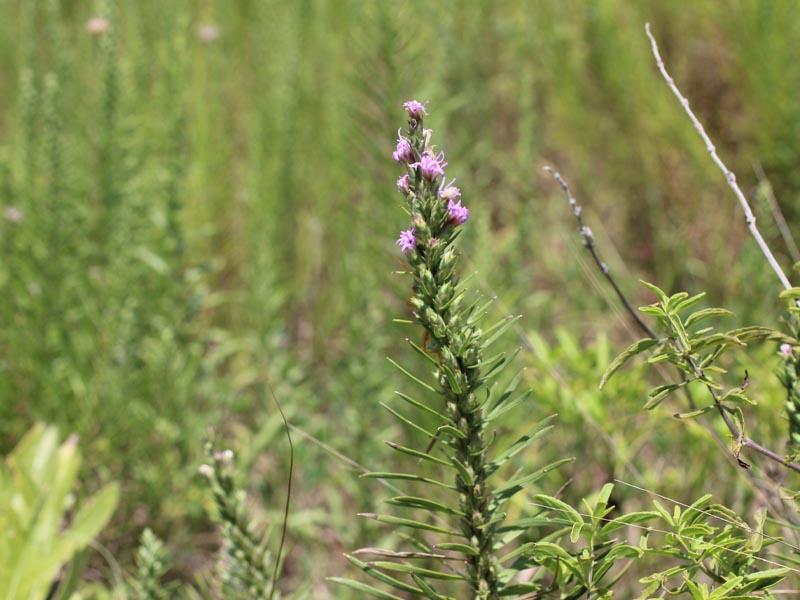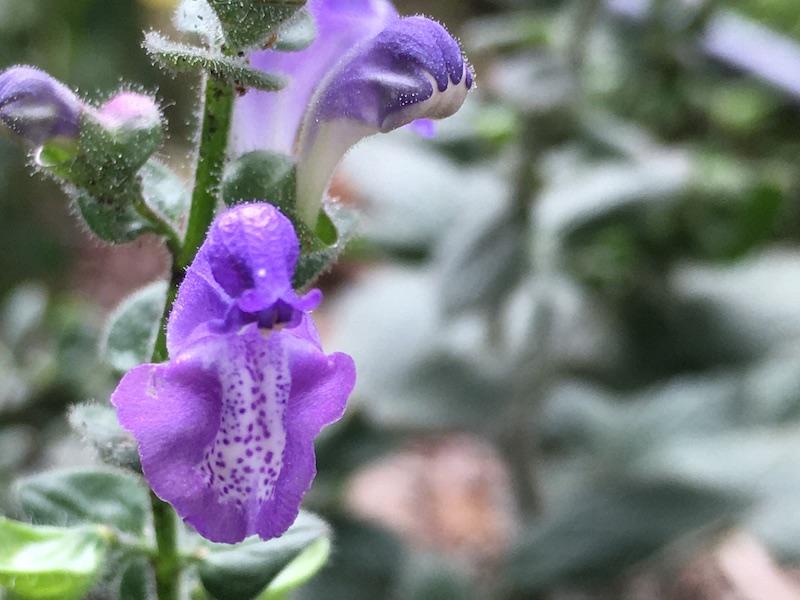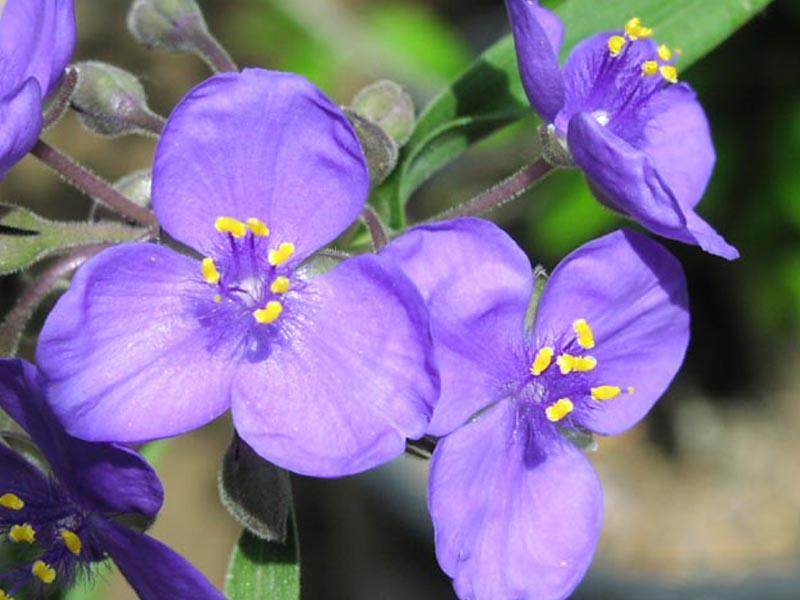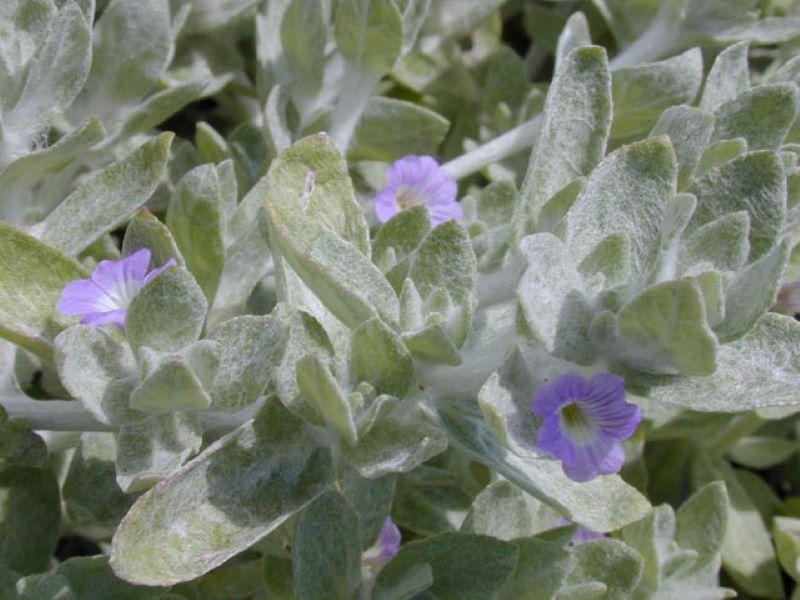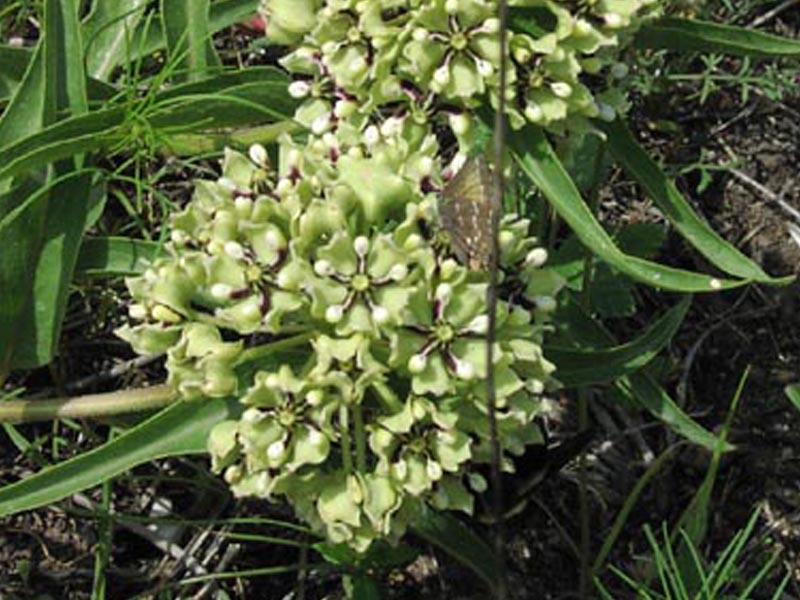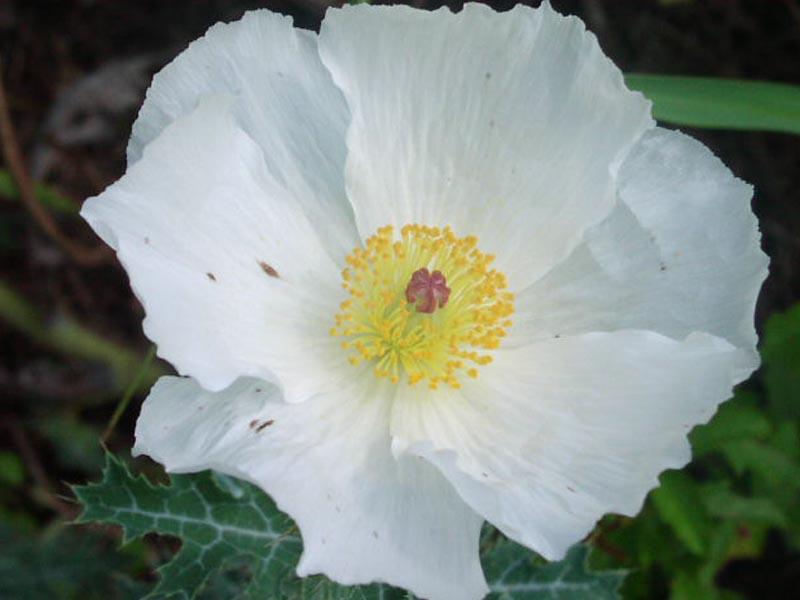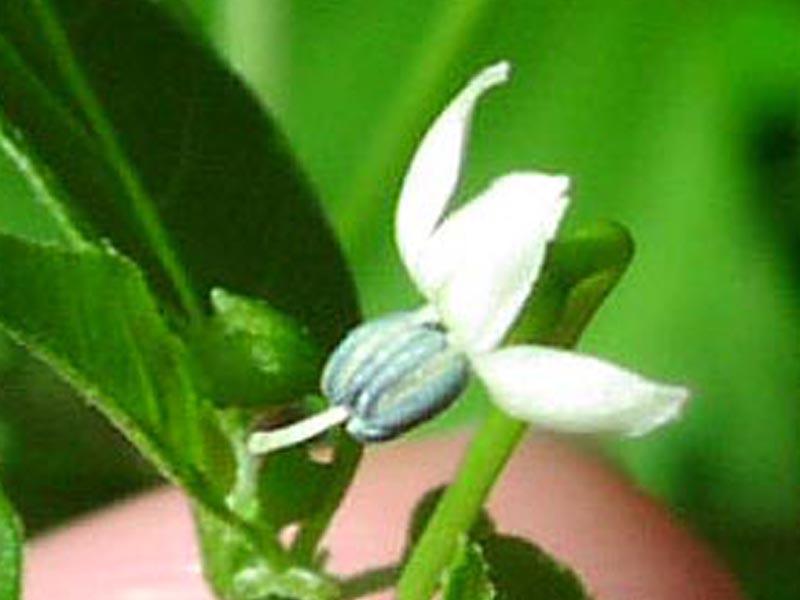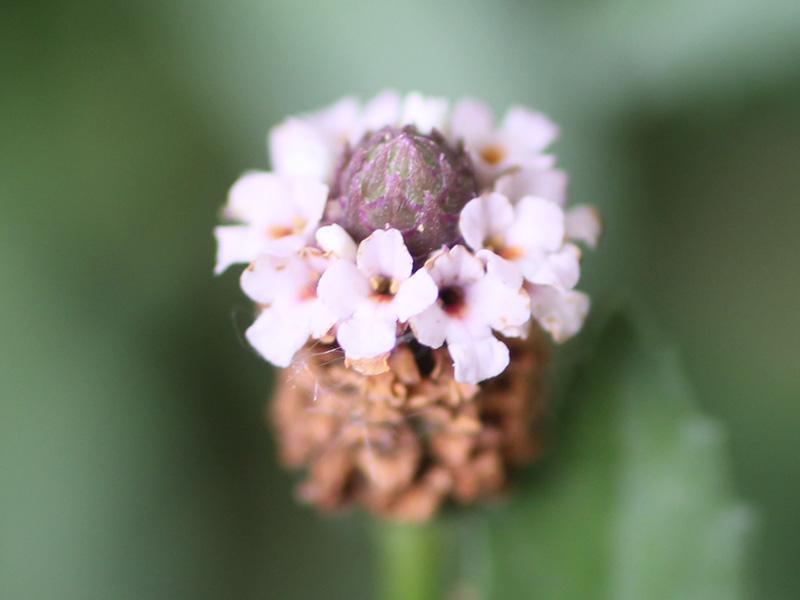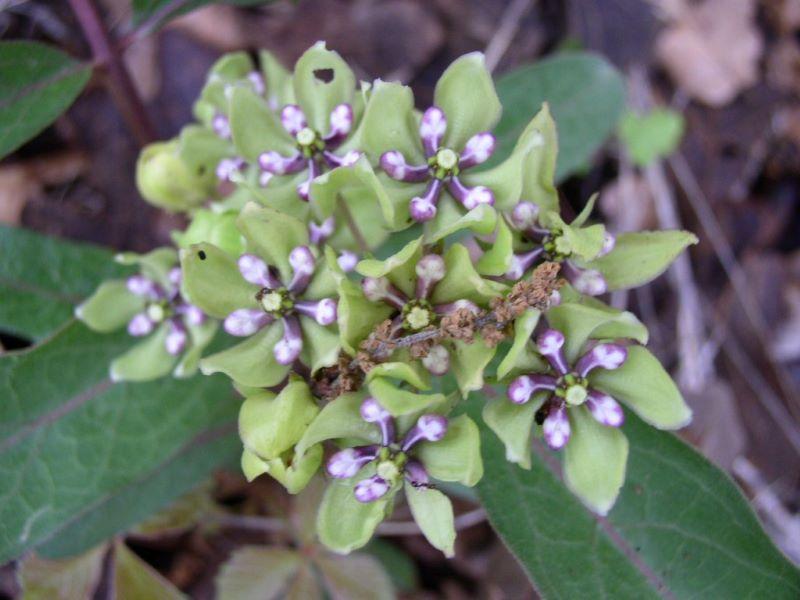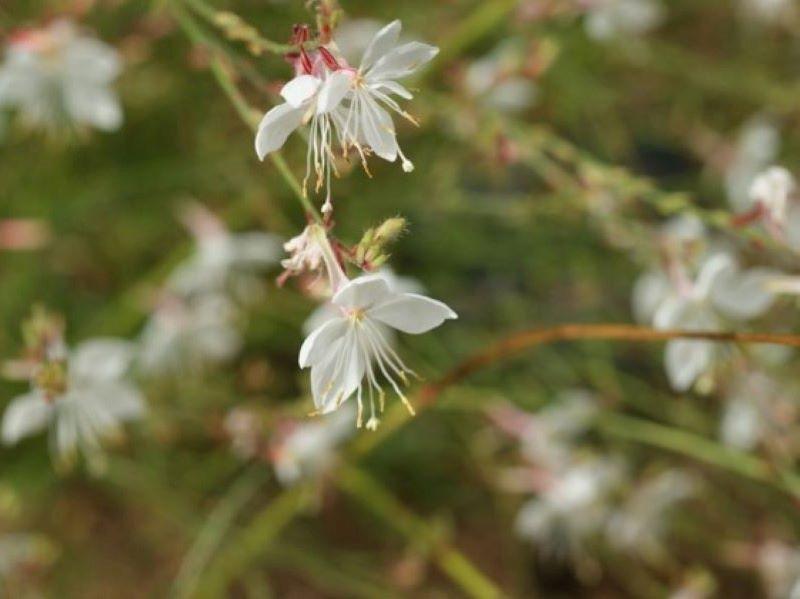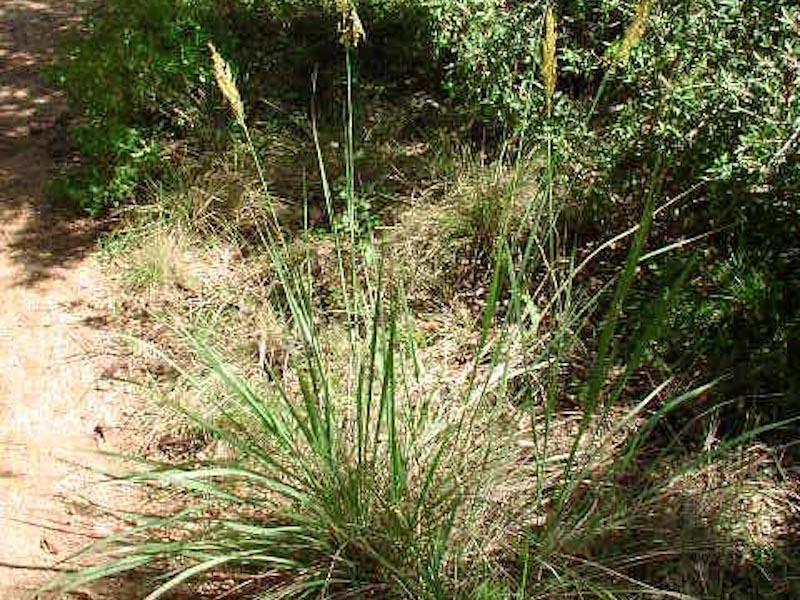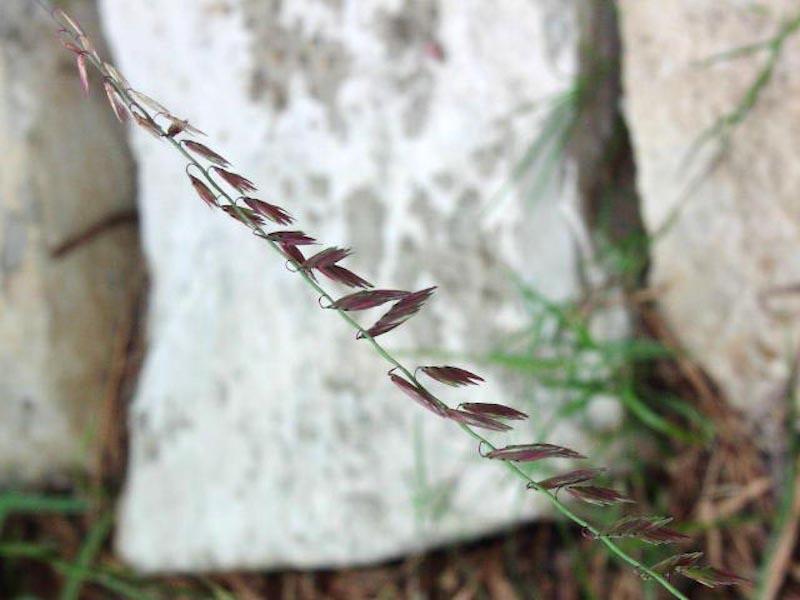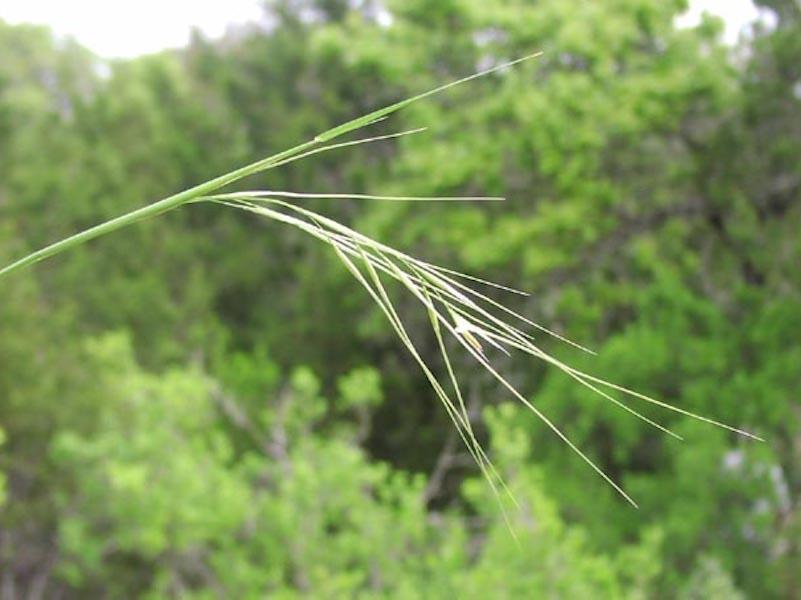|
PURPLE CONEFLOWER
Echinacea purpurea (Asteraceae)
Bloom time: April – September
These flowers are reported to contain a boost for the immune system and are often found in tea
|
EVENING PRIMROSE
Oenothera speciosa (Onograceae)
Bloom time: February – July
This grassland native plant can form large colonies by seed and runner
|
|
GOLDENEYE PHLOX
Phlox roemeriana (Polemoniaceae)
Bloom time: February – May
Only butterflies, moths and other insects with a very long & narrow proboscis can pollinate
Image from BIO 406D database |
AMERICAN BEAUTYBERRY
Callicarpa americana (Verbenaceae)
Bloom time: May – July
In the Fall, this shurb has clumps of bright purple fruit (drupes) |
|
CORALBERRY
Symphoricarpos orbiculatus (Caprifoliaceae)
Bloom Time: April – July
A colonizing, deciduous shrub of Post Oak woodlands; flowers are white
Unresricted image from Wildflower Center |
WILD RED COLUMBINE
Aquilegia canadensis (Ranunculaceae)
Bloom Time: February – July
See the five sepals and petals elongated into spurs that contain nectar |
|
CEDAR SAGE
Salvia roemeriana (Lamiaceae)
Bloom time: March – August
These are typically found in dry sites underneath Juniperus ashei (hence "cedar") |
INDIAN PAINTBRUSH
Castilleja indivisa (Scrophulariaceae)
Bloom time: March-May
The roots grow until they find another plant's roots from which they steal nutrients |
|
TURKS CAP
Malvaviscus arboreus var. drummondii (Malvaceae)
Bloom Time: May – November
The variety name comes from the Scottish naturalist Thomas Drummond |
STANDING CYPRESS
Ipomopsis rubra (Polemoniaceae)
Bloom Time: May – July
A stiff 2 to 6 foot tall biennial that attracts hummingbirds |
|
INDIAN BLANKET
Gaillardia pulchella (Asteraceae)
Bloom time: May – August
These flowers are almost completely red in the sandy soils of the Llano uplift |
TEXAS LANTANA
Lantana urticoides (Verbenaceae)
Bloom Time: April – October
Its crinkly leaves can cause a skin rash |
|
MEXICAN HAT
Ratibida columnifera (Asteraceae)
Bloom Time: May – October
Belonging to a group of composites called coneflowers, its unopened disk flowers are green |
BUTTERFLY WEED
Asclepias tuberosa (Asclepiadaceae)
Bloom Time: May – September
Native Americans used the root to cure lung problems
|
|
TREE TOBACCO
Nicotiana glauca (Solonaceae)
Bloom Time: All year
Tall, toxic, nonnative bush that was introduced from South America |
LARGE BUTTERCUP
Ranunculus macranthus (Ranunculaceae) *
Bloom Time: March – April
The Large Buttercup is completely poisonous, though toxicity is minor if eaten |
BLACK-EYED SUSAN
Rudbeckia hirta (Asteraceae)
Bloom Time: June – October
Root Tea was used by native Americans to treat worms, colds, and snakebites
|
PARTRIDGE PEA
Chamaecrista fasciculate (Fabaceae)
Bloom Time: June – October
This plant relies on microorganisms in the root system to produce necessary nitrogen compounds
|
|
FOUR-NERVE DAISY
Hymenoxys scaposa (Asteraceae)
Bloom time: March-April
This plant has a densely hairy stem and is one of the largest native buttercups |
TEXAS YELLOWSTAR
Lindheimera texana (Asteraceae) *
Bloom Time: March – May
Because leaves grow slowly through winter, it is a winter annual like the bluebonnet |
|
HORSEHERB
Calyptocarpus vialis (Asteraceae)
Bloom Time: March – November
This tiny flower is kin to daisies & sunflowers in one of the largest families of flowering plants |
MAXIMILIAN SUNFLOWER
Helianthus maximiliani (Asteraceae)
Bloom Time: August – November
This sunflower can be eaten by deer and a variety of birds |
|
COREOPSIS
Coreopsis tinctoria (Asteraceae)
Bloom Time: April – June
This wildflower does well in meadows during wet years
|
|
|
AGARITA
Mahonia trifoliolata (Berberidaceae)
Bloom Time: February – April
The berry of this plant is edible |
ENGLEMANN’S DAISY
Engelmannia peristenia (Asteraceae)
Bloom Time: March – July
Popular on roadsides, this daisy can survive even in drought |
|
FALSE GOLDEN ASTER
Heterotheca camporum (Asteraceae)
Bloom Time: July – December
A wide-spread (from New York to South Texas and Florida) native flower |
AMERICAN BASKETFLOWER
Centaurea americana (Asteraceae)
Bloom Time: May – June
The name basket comes from the stiff, straw-colored bracts just beneath the flower head |
|
TEXAS SAGE
Leucophyllum frutescens (Scrophulariaceae)
Bloom Time: All year
This drought-tolerant shrub is typically 2-5 feet but can get much taller |
BLUEBONNET
Lupinus texensis (Fabaceae)
Bloom Time: March – May
The flower of Texas varies in toxicity, relative to an individual's weight, age, fitness, and susceptibility |
|
MEALY BLUE SAGE
Salvia farinacea (Lamiaceae)
Bloom Time: April – October
This sage is of low water usage and prefers slightly acidic soil
|
PRAIRIE VERBENA
Glandularia bipinnatifida (Verbenaceae)
Bloom Time: March – October
This plant is sometimes referred to as Moradilla, which means, "little purple one"
|
|
LEMON BEEBALM
Monarda citriodora (Lamiaceae)
Bloom Time: May – July
In addition to attracting bees, humans have used its leaves for flavoring in salads, cooked meals, and tea |
WINECUP
Callirhoe involucrate (Malvaceae)
Bloom Time: March – June
Inhaling the crushed, dried, and burned roots has been used as an aid to head colds |
|
ERYNGO
Eryngium leavenworthii (Apiaceae)
Bloom Time: July – September
The bloom is often confused for a thistle, giving it the nickname, "false purple thistle"
Image from BIO 406D database |
GREG'S DALEA
Dalea greggii (Fabaceae)
Bloom Time: July – September
This plant is named after Josiah Gregg, a geologist/botanist from the 1800's
Image from BIO 406D database |
|
FALL ASTER
Symphyotrichum oblongifolium (Asteraceae)
Bloom Time: September – November
These purple flowers are of special value to native bees |
TEXAS GAYFEATHER
Liatris punctata var. mucronata (Asteraceae)
Bloom Time: August – December
This palnt is 1-3 feet tall and attractive to butterflies |
|
HEARTLEAF SKULLCAP
Scutellaria ovata (Lamiaceae)
Bloom Time: April – June
This pollinator/hummingbird plant from the mint family is great for shady spots |
GIANT SPIDERWORT
Tradescantia gigantea (Commelinaceae)
Bloom Time: March – April
T. gigantea was named after the garderner of Charles I, Josh Tradescant |
|
WOOLLY STEMODIA
Stemodia lanata (Scrophulariaceae)
Bloom Time: April – November
The Wooly Stemodia can be evergreen in regions with mild winter
Unrestricted image from Wildflower Center |
ANTELOPE HORNS
Asclepias asperula (Asclepiadaceae)
Bloom Time: March – October
Antelope Horns are inevitable hosts to aphids, which usually is not a problem
Image from BIO 406D database |
|
WHITE PRICKLYPOPPY
Argemone albiflora (Papaveraceae)
Bloom Time: March – July
This flower is toxic and in some cases can prove fatal upon human ingestion
Image from BIO 406D database |
CHILE PEQUIN
Capsicum annuum (with red fruit) (Solanaceae)
Bloom Time: May – October
This bloom is actually a small and very hot pepper
Image from BIO 406D database |
|
TEXAS FROGFRUIT
Phyla nodiflora (Verbenaceae)
Bloom Time: May – October
These tiny flowers can survive drought, frost, and flooding |
GREEN MILKWEED
Asclepias viridis (Asclepiadaceae)
Bloom Time: April – September
A toxic milky substance visually similar to Elmer's Glue is exuded when the plant is broken apart
Image from BIO 406D database |
|
TEXAS OR WHITE MILKWEED
Asclepias texana (Asclepiadaceae)
Bloom Time: May – September
Toxicity among milkweeds can vary with season and even if the plant has absorbed herbicides and pollutants
|
BLACKFOOT DAISY
Melampodium leucanthum (Asteraceae)
Bloom Time: March – November
These honey-scented blooms prefer rocky soil |
|
WHITE GAURA
Oenothera lindheimeri (Onograceae)
Bloom Time: April – July
Named for Ferdinand Jacob Lindheimer who described several hundred plant species from 1843-1852
Unrestricted image from Wildflower Center |
POKEWEED
Phytolacca americana (Phytolaccaceae)
Bloom Time: July – October
Tall bush with berries can be used as a dye or ink |
|
INDIAN GRASS
Sorghastrum nutans (Poaceae)
Bloom Time: August – October
A bunching warm-season grass of the Blackland prairie ecosystem with plume-like seed heads
Image from BIO 406D database |
SIDEOATS GRAMA
Bouteloua curtipendula (Poaceae)
Bloom Time: July – September
This is the state grass of Texas!
Image from BIO 406D database |
|
TEXAS CUP GRASS
Eriochloa sericea (Poaceae)
Bloom Time: May – October
Up to 3.5 foot-tall prairie grass common to the Edward's Plateau
Image from Half Pint Prairie |
TEXAS WINTER GRASS
Nassella leucotricha (Poaceae)
Bloom Time: March – June
Cool-season grass that grows up to 3.5 feet tall
Image from BIO 406D database |
|
TEXAS BLUEGRASS
Poa arachnifera (Poaceae)
Bloom Time: March – May
Cool season native grass for sun or shade
Image from Half Pint Prairie |
PRAIRIE WILDRYE
Elymus canadensis (Poaceae)
Bloom Time: March – June
Short-lived, cool-season grass with early Fall seed heads
Image from Half Pint Prairie |
